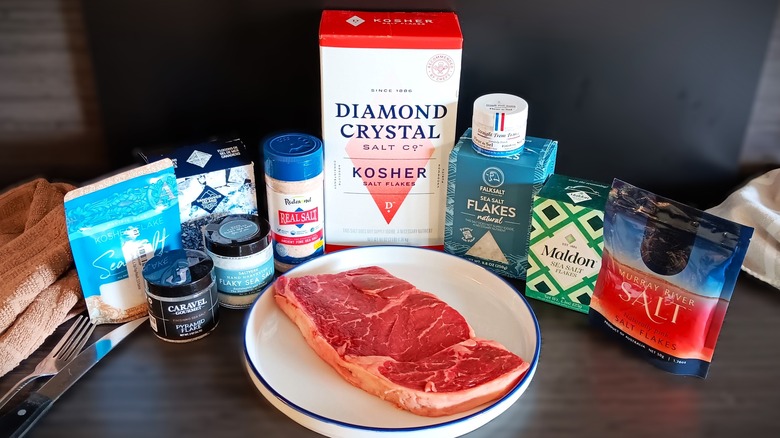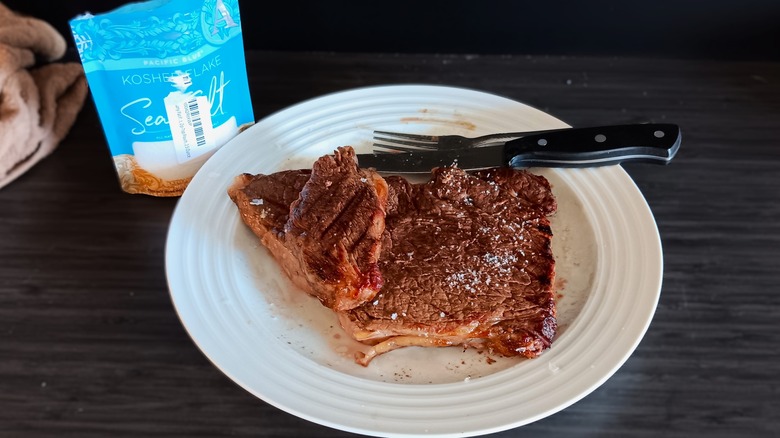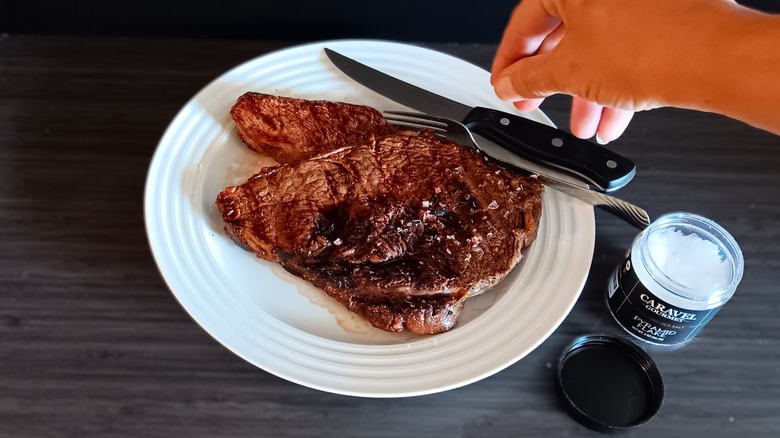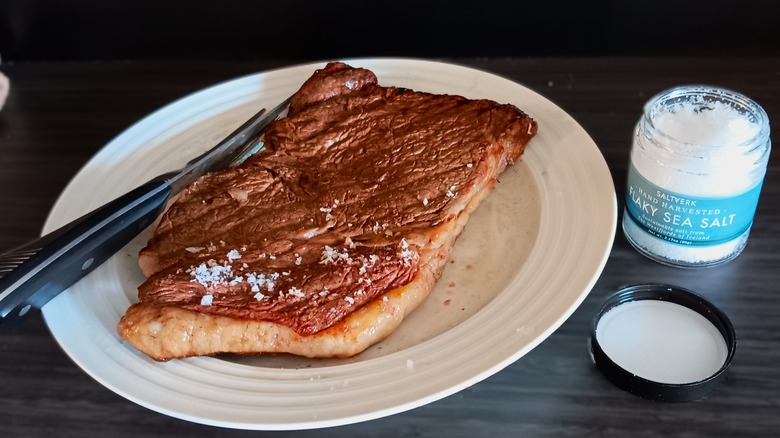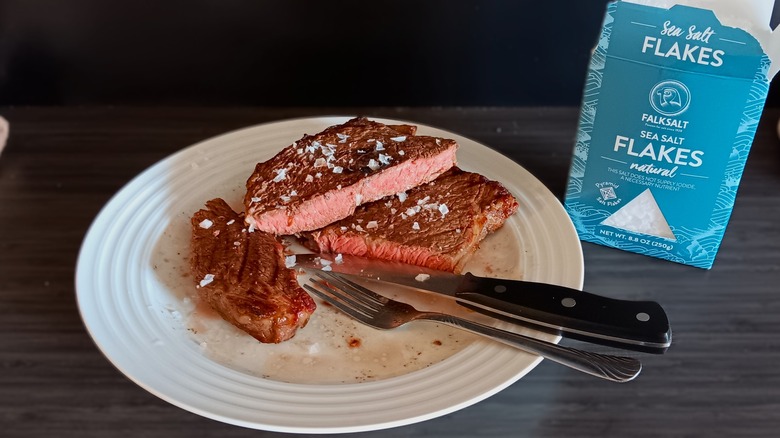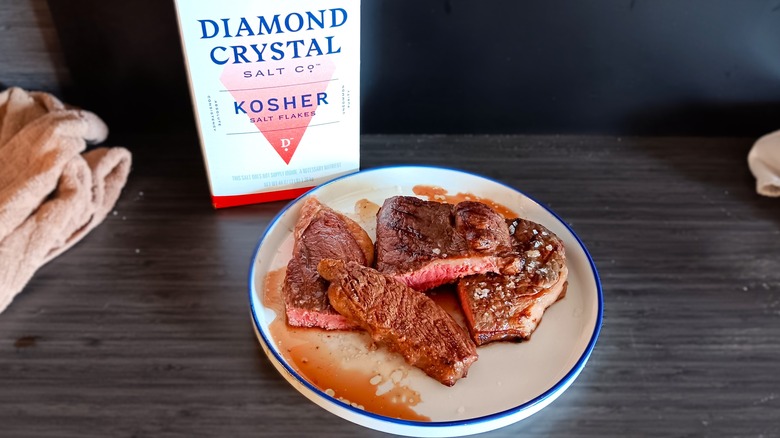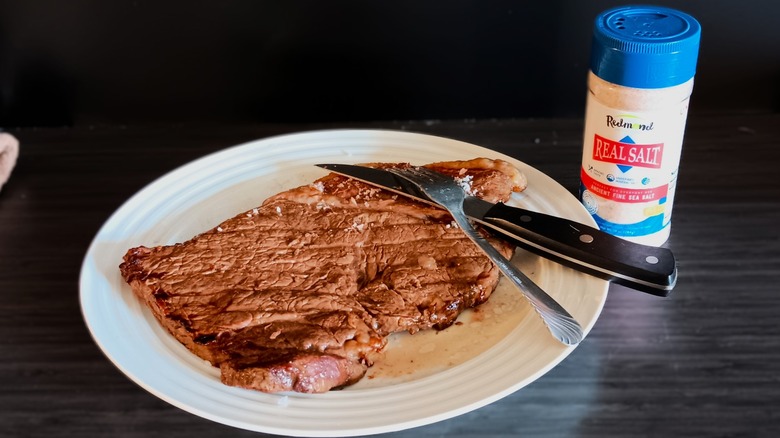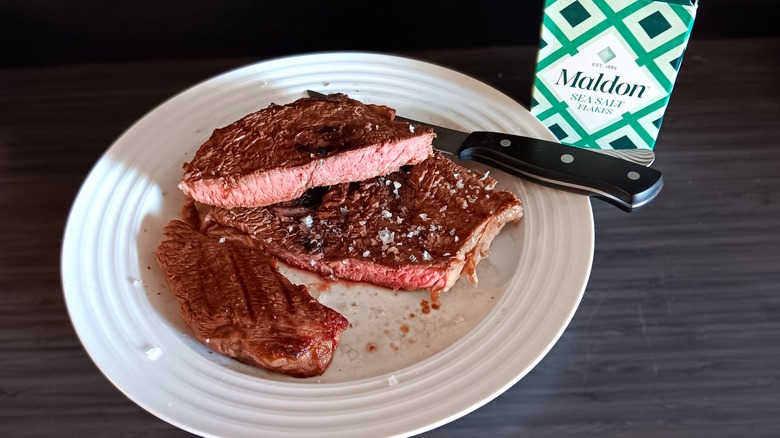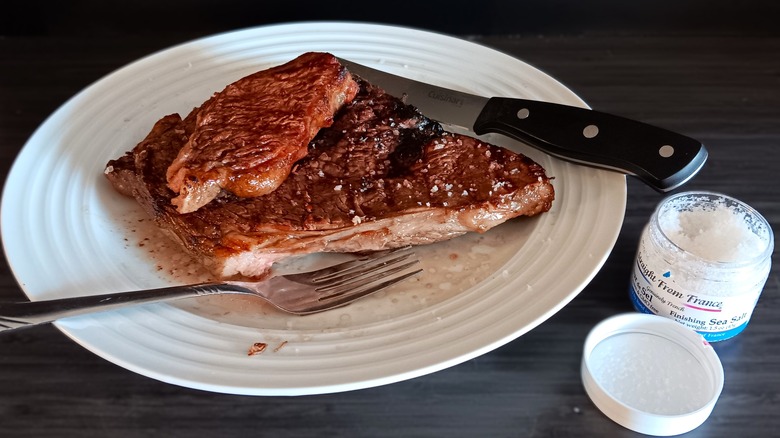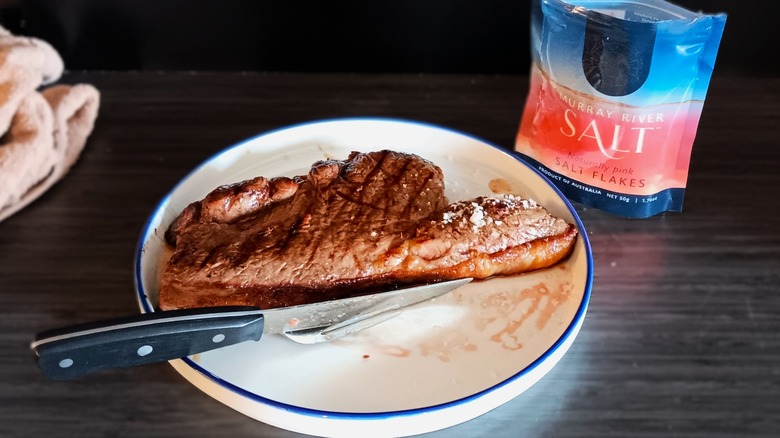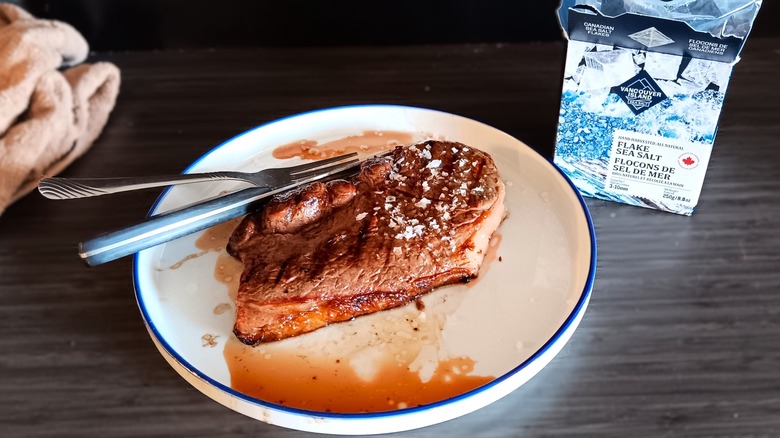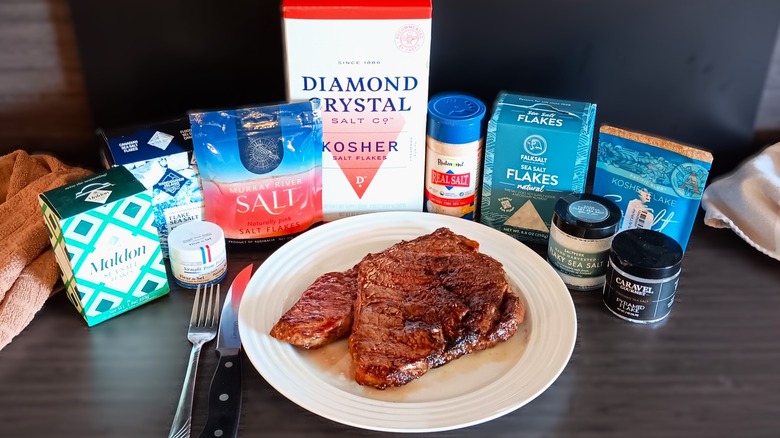10 Finishing Salts For Steak, Ranked
A perfectly grilled steak doesn't need anything more than a good finishing salt (except maybe a fork and knife to eat it with). Though all salt is made up of sodium chloride, the mineral content varies among different types of salt depending on where the salt originates. Harvested from land or sea — mined or separated from water — the resulting salt crystals contain electrolytes like calcium, potassium, and magnesium. The amount and combination of these electrolytes, plus additional trace minerals, contribute to the size, shape, and color as well as the taste, texture, and optimal use of salt.
From traditional table salt to fancy finishing salt, therein lies a wide range of enhancements for foods, both savory and sweet. But beyond being a natural preservative, salt boosts the flavor of your steak. The right salt complements the slight acidity of meat while balancing the richness of fat, creating a concentrated, beefy bite.
I set out to find just the right finishing salt that pairs best with steak. You can learn more about the methodology at the end of this story, but you really can't go wrong with any of the salts I tried. In my quest to review 10 different salts, I ate just over 3 pounds of steak to test them all and bring you these results, starting with the worst and counting our way down to the top spot.
10. SaltWorks Pacific Blue Flake Sea Salt
Harvested from the Pacific Ocean, SaltWorks Pacific Blue Flake Sea Salt is a kosher finishing salt that features hollow, pyramid-shaped crystals. Pacific Blue salt is unrefined and additive-free and can be classified as organic. With no chemical processing, this salt includes trace minerals that add flavor to whatever food you choose to use it with. Lighter and fluffier than granular sea salt, Pacific Blue offers its flakes in four different sizes.
Pacific Blue ranks lowest on our list because I found it to be incredibly salty. Though this sounds like an oxymoron — after all, it is salt — it is a fine-to-small-sized salt that would be very easy to overdo as you sprinkle it on your steak. It leaves a very salty aftertaste that requires a large volume of water to wash it down, which is not what I'm looking for when I cut into my ribeye or New York strip. That said, it's still a good salt that can be used in any number of recipes.
9. Caravel Gourmet Salt
Caravel Gourmet Flaky Fine finishing sea salt is hand-crafted in small batches and goes through a strict inspection process to create a high-quality product. Considered a fleur de sel from France, this salt features flake crystals that come from the surface of evaporated water, where they form the desired pyramid shape. Typically raked by hand in order to not disturb the salt's delicate nature, this type of finishing salt is known for its light, fluffy look and texture.
As one of several fleur de sel options on our list, Caravel comes in lowest because I just wasn't impressed. These medium-to-large flakes melted a little bit on top of warm steak since they were light and thin in shape. But I found them to be pretty salty — the kind of saltiness that hangs on the tongue and requires a large gulp of water to wash it down. Even using just a little bit of flakes was fairly salty.
8. Saltverk Flaky Sea Salt
Saltverk is a sea salt sourced from Icelandic waters in Reykjanes, which is located on a small peninsula. Reykjanes is said to have some of the cleanest seawater, which is why Saltverk sticks with using the same method of harvesting salt as it did in the 17th century. Using 100% geothermal energy, salt is produced with water from local hot springs, making it one of the few sustainable salt producers in the world. A brine is created and then boiled until flaky salt crystals form. It's drained and hand-raked to gather up the pyramid-shaped salt. Then, it's dried and packaged.
Saltverk features medium-sized flakes that were still pretty crunchy on a warm, rested steak. I also found them to be rather salty, though I didn't use that much. This flake salt wasn't overly memorable but was still tasty enough. With all the choices of finishing salt on the market, I wouldn't opt for this one first, but I wouldn't say no to it, either.
7. Falksalt Sea Salt Flakes
Falksalt is a sea salt that comes from an underground, desert Mediterranean seabed before being refined and packed on the west coast of Sweden. Considered one of the oldest brands in that country, Falksalt finishing salt is harvested from evaporated seawater that comes from shallow basins. The water is evaporated using just the sun. Salt crystals form on the surface of the water, where the crystals are cleaned and then dried. The crystals grow at different rates, and those that form on the outer edges of the basins grow into pyramids or hollow cubes, which are the crystals that are cultivated as flakes.
Falksalt featured some of the largest and thickest flakes among the brands on this list. They are too large, in my opinion. Perhaps needless to say, the flakes didn't melt at all on warm steak. It also took work to crunch the flakes, and I'd rather my steak take center ring when chewing. Ironically, it took a lot of flakes to really taste the salt. Though I wouldn't recommend Falksalt flakes as your choice for topping steak, this type of flake would match well with a sweet treat that benefits from a light, salty crunch.
6. Diamond Crystal Salt Flakes
Diamond Crystal has been around since 1886 and has been used and favored by chefs and home cooks alike for its simple, pure flavor. Focused on quality, this salt is an additive-free product that doesn't go through any type of mechanical process in order to keep its delicate crystal shape. Diamond Crystal Salt Flakes is a kosher salt that features hollow crystals, which reportedly contain more than 50% less sodium than table salt. These salt flakes are big enough to pick up with your fingers, yet fragile enough to crush for seasoning in your recipes.
My initial impression wasn't great since the salt doesn't resemble flakes at all. It's actually fairly fine salt that I managed to, accidentally, get all over the table when I poured it into my hand. But it's very tasty and surprisingly light on the saltiness. It isn't overpowering (especially since it is so fine), and I rather enjoyed its delicate nature.
5. Redmond's Real Salt
Redmond's Real Salt is another popular salt for seasoning steak and other meats. This unrefined sea salt is mined from an ancient seabed in Utah where it's protected from surface exposure. Redmond's Real Salt features more than 60 trace minerals, which give the salt its pleasant, subtly sweet, but not overly salty, taste. This salt is pure and unprocessed and can be used in organic production of other foods. Its varieties range from fine to coarse, certified kosher, and smoked.
Before this taste-tested salty article, Redmond's was my go-to salt for everything. In fact, I was sure it would stay as my No. 1 choice. But alas, it got bumped by a handful of other brands. But many steak enthusiasts give two thumbs up for the realness of Redmond's (as do I). Unlike other finishing salts, Redmond's Real Salt in the fine grain dissolves like typical salt. Redmond's remains among my top choices since it has a good salt taste that you can count on and matches well with a variety of foods. It's also a lot easier to find in stores compared with some other brands.
4. Maldon Salt Flakes
Maldon salt has a bit of a cult following. Going so far as to be recommended by the late Queen Elizabeth, this flaked finishing salt hails from the coastal town of Maldon, England. For more than 140 years, Maldon has been hand-harvested in small batches by the Osborne family. Now produced by the fourth generation, the salt is made from a brine that comes from Blackwater Estuary where it's boiled and held at a certain temperature until the desired salt crystals form. It's then raked by hand and dried. The result is giant, pyramid-shaped salty flakes that present with an underlying sweetness.
A popular contender to season ribeyes or sirloin with, Maldon sea salt flakes are favored by steak lovers everywhere. Though I have personally tried many different salts, this was my first taste of Maldon. I sprinkled the flakes, which are small to medium in size, on a warm sirloin steak that had rested for about 5-10 minutes. The flakes melted a little bit but mostly remained crunchy. I found this salt to taste like regular salt and was not as impressed as many other meat-eaters seem to be. I thought for sure this salt would rank higher on the list, but it tops out in the No. 4 spot.
3. Straight From France Fleur De Sel
True to its name, this fleur de sel — French for "flower of salt" — is imported straight from France. Hand-harvested in the Guerande, Camargue, and Re Island regions, this sea salt is considered the purest form of salt — unrefined, unprocessed, and unadulterated. Family owned and operated, Straight From France offers its fleur de sel as a finishing salt with more of a crystal shape than flake, and it features a high moisture content. Though it's more compact than the traditional light salt flake, it's not that granular like fine or coarse sea salt, either.
There's a reason why fleur de sel finishing salt is something to splurge on. I wasn't sure what to expect. After testing multiple salts before this one, I didn't think I could still be impressed. But I definitely was and am surprised to be ranking this one higher — even above Maldon and Redmond's brands, as a matter of fact. These small-to-medium-sized flakes melt a little bit on rested steak but are light and still feature a little bit of crunch. It was a nice combination to bite into. It was tasty, not overly salty, and left no aftertaste.
2. Murray River Salt Flakes
Murray River Salt is sourced, packaged, and shipped straight from Australia and is billed as the continent's only naturally pink salt. The light pink color is a result of mineralized brines that are full of magnesium, calcium, and other elements. Originating from the Mildura region, the Murray River Salt company is, and has always been, family-owned and operated. This award-winning salt comes from an underground saline water source — the Murray Darling basin — that's been there for thousands of years and protected from the elements. The salt is crystallized using the power of the sun, a process that only happens during the summer.
I was quite impressed with the taste and texture of Murray River Salt. Sprinkled on a sirloin steak that had the chance to rest, this small-to-medium-sized flake salt barely melted. It remained a bit crunchy and had a pleasant salty taste that wasn't overwhelming; it complemented the beef nicely. The saltiness didn't linger on the tongue the way most salt does. I found this refreshing. It is definitely one of my favorites.
1. Vancouver Island Flaky Sea Salt
From the shorelines of Vancouver Island in Canada, this flaky finishing sea salt is harvested from glacier-fed waters that provide an unparalleled blend of more than 40 trace minerals. The water is collected at high tide, where the currents meet from both the north and south, which means the water is constantly in motion. The resulting salt is hand-harvested in small batches and includes micro-filtering to keep the salt as pure as possible. After filtration, the water is boiled to create a brine and then moved to shallow evaporation tanks where pyramid-shaped crystals form.
Unexpectedly, Vancouver Island Flaky Sea Salt is my favorite. The medium-to-large flakes are crunchy but light. Compared to some of the other crunchy flake salts, this crunch was more delicate, which I enjoyed better. Even though the flake was lighter and not as compact as others, it still didn't melt on a warm steak. But the salt level was ideal and complemented the steak to such a degree that I ate a good portion of it before moving on to another salt. It had a nice taste that didn't bite back and didn't leave me with a lingering salty taste in my mouth.
Methodology
One of the things you need to know about salt is that there's a wide variety of types available for seasoning. Because of this extensive variety, just narrowing down a list of finishing salts was a salty task. My initial list was derived from online reviews and recommendations from a number of steak lovers who are serious about their salt. Though I have my personal favorites, I also gave weight to what folks had to say about the most popular brands online. From there, I narrowed the list down further for the sake of length, so I could purchase the salts to test on steak.
Mostly, I was aiming for the best flavor — the salt that enhanced the steak the best and added a nice salty touch. But I also compared my own findings with what the brands claim. Some folks are interested in keeping the crunch of finishing salt, while others prefer it to dissolve. I salted the steaks after they rested for 5-10 minutes so they were not piping hot. Therefore, the salt was less apt to melt anyway.
